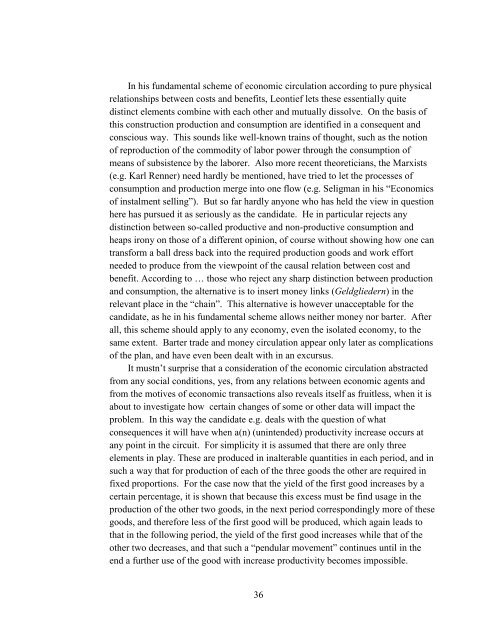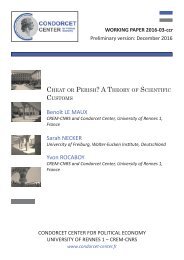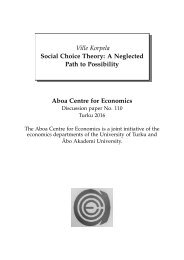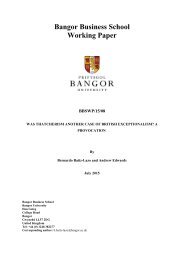MEMORANDUM
n?u=RePEc:hhs:osloec:2016_018&r=hpe
n?u=RePEc:hhs:osloec:2016_018&r=hpe
Create successful ePaper yourself
Turn your PDF publications into a flip-book with our unique Google optimized e-Paper software.
In his fundamental scheme of economic circulation according to pure physical<br />
relationships between costs and benefits, Leontief lets these essentially quite<br />
distinct elements combine with each other and mutually dissolve. On the basis of<br />
this construction production and consumption are identified in a consequent and<br />
conscious way. This sounds like well-known trains of thought, such as the notion<br />
of reproduction of the commodity of labor power through the consumption of<br />
means of subsistence by the laborer. Also more recent theoreticians, the Marxists<br />
(e.g. Karl Renner) need hardly be mentioned, have tried to let the processes of<br />
consumption and production merge into one flow (e.g. Seligman in his “Economics<br />
of instalment selling”). But so far hardly anyone who has held the view in question<br />
here has pursued it as seriously as the candidate. He in particular rejects any<br />
distinction between so-called productive and non-productive consumption and<br />
heaps irony on those of a different opinion, of course without showing how one can<br />
transform a ball dress back into the required production goods and work effort<br />
needed to produce from the viewpoint of the causal relation between cost and<br />
benefit. According to … those who reject any sharp distinction between production<br />
and consumption, the alternative is to insert money links (Geldgliedern) in the<br />
relevant place in the “chain”. This alternative is however unacceptable for the<br />
candidate, as he in his fundamental scheme allows neither money nor barter. After<br />
all, this scheme should apply to any economy, even the isolated economy, to the<br />
same extent. Barter trade and money circulation appear only later as complications<br />
of the plan, and have even been dealt with in an excursus.<br />
It mustn’t surprise that a consideration of the economic circulation abstracted<br />
from any social conditions, yes, from any relations between economic agents and<br />
from the motives of economic transactions also reveals itself as fruitless, when it is<br />
about to investigate how certain changes of some or other data will impact the<br />
problem. In this way the candidate e.g. deals with the question of what<br />
consequences it will have when a(n) (unintended) productivity increase occurs at<br />
any point in the circuit. For simplicity it is assumed that there are only three<br />
elements in play. These are produced in inalterable quantities in each period, and in<br />
such a way that for production of each of the three goods the other are required in<br />
fixed proportions. For the case now that the yield of the first good increases by a<br />
certain percentage, it is shown that because this excess must be find usage in the<br />
production of the other two goods, in the next period correspondingly more of these<br />
goods, and therefore less of the first good will be produced, which again leads to<br />
that in the following period, the yield of the first good increases while that of the<br />
other two decreases, and that such a “pendular movement” continues until in the<br />
end a further use of the good with increase productivity becomes impossible.<br />
36





